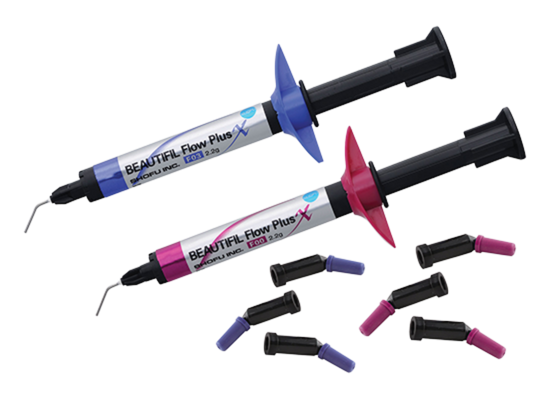Write your awesome label here.
Product Review:
Shofu Beautifil Flow Plus X

Multi-Use
Beautifil Flow Plus X
Beautifil Flow Plus X is a bioactive injectable hybrid restorative with nano S-PRG filler. It offers fluoride release, self-leveling, stackable, and sculptable properties, and blends with natural tooth shades for durable, shiny restorations.
Write your awesome label here.
Solving the Riddle of Deep Restorations Liners
Catapult evaluators set out to find out if Shofu’s Beautifil Flow Plus X is a product that checks all the boxes. [written by Ankur Gupta, DDS]

Beautifil Flow Plus X is a bioactive injectable hybrid restorative with a newly developed patented nano S-PRG filler. It is formulated with Giomer chemistry, including fluoride release and recharge, and features improved handling and polishing to maintain a long-lasting shine. Beautifil Flow Plus X is self-leveling, stackable, and sculptable. It esthetically blends with the natural tooth shade and features a high flexural strength.
After practicing for nearly 20 years, I still get that tingle of anxiety when I remove decay from a supposedly simple cavity and the decay extends deeper than I had anticipated.
The patient was expecting a simple filling. The patient was expecting the tooth to not be sensitive afterward. The patient was not planning to hear me say, “Um, you know that simple filling that was going to cost a little bit? Well, the decay was deeper than I expected, so now you need a root canal, buildup, and crown. And it will cost a lot.”
Whenever a restoration is deep and we choose to move forward without endodontic therapy, the possibility exists that the patient will show up to the office later, frustrated about sensitivity. Because of this, clinical dentistry has been introduced over the past 5 decades to a myriad of bases, liners, and varnishes with the principal responsibility to provide a buffer between the nearly exposed viable pulpal tissue and the restoration.
The patient was expecting a simple filling. The patient was expecting the tooth to not be sensitive afterward. The patient was not planning to hear me say, “Um, you know that simple filling that was going to cost a little bit? Well, the decay was deeper than I expected, so now you need a root canal, buildup, and crown. And it will cost a lot.”
Whenever a restoration is deep and we choose to move forward without endodontic therapy, the possibility exists that the patient will show up to the office later, frustrated about sensitivity. Because of this, clinical dentistry has been introduced over the past 5 decades to a myriad of bases, liners, and varnishes with the principal responsibility to provide a buffer between the nearly exposed viable pulpal tissue and the restoration.
Liner Options
Many of these agents attempt to reduce pulpal inflammation and sensitivity by releasing ions and/or maintaining ideal pH in that incredibly fragile space that differentiates a simple filling from full-fledged endodontic therapy. In extremely brief and simple terms, these liner options include the following.
Calcium Hydroxide
This is a highly basic material (pH value of
approximately 11) alleged to irritate the surrounding dentin and therefore stimulate reparative dentin. Sadly, the seal does not last, microleakage is common, and calcium hydroxide does not possess similar hardness to either dentin or the overlying restorative material.
Glass Ionomer
The 2 benefits of most resin-modified glass ionomer options are their ability to ionically bond to the underlying tooth structure and their release of fluoride. Disadvantages include high sensitivity to moisture, poor polishability, and an overall hardness that does not match either tooth structure or the potential overlying composite.
Bonded Flowable Resins
These have been a popular answer to the hardness and polishability question, but when compared with resin-modified glass ionomers, bonded flowable reins do not perform as well in reducing microleakage. Moreover, these resins do not possess the same ability to continually release pulp-
friendly and bacteria-unfriendly ions.
This disparity in liner options has left most dentists without a clear answer until recently...
Shofu Dental, a supply manufacturer of abrasives, cameras, and various restorative materials, introduced Giomer technology to the dental market. Giomer-based restorative materials from the Beautifil line are unique in that they:
92% of survey respondents reported that the results of these restorations were excellent. The remaining 8% reported that the results were very good.
Survey respondents were asked to rank one of the following options as their favorite feature of this flowable product. Although some respondents were most impressed with the Giomer properties and polishability, most respondents were incredibly impressed with the handling. Giomer bioactivity, found in the Beautifil line of restorative materials, is said to do the following:
Survey respondents were asked to rank one of the following options as their favorite feature of this flowable product. Although some respondents were most impressed with the Giomer properties and polishability, most respondents were incredibly impressed with the handling. Giomer bioactivity, found in the Beautifil line of restorative materials, is said to do the following:
One of the features of this product is the reduced filler particle size, which allows the product to polish in less time and with a higher level of gloss. Regarding this feature, 100% of survey respondents found the resultant polishability to be “excellent, outstanding, and next level.”
It is incredibly rare for a product to achieve a 100% rating from every participant. For this reason, it is without hesitation that we would like to bestow the Catapult Vote of Confidence™ to Shofu Dental for their Beautifil Flow Plus X restorative product.
Say NO to boring CE.
Enter your email to stay in the loop about all
new on-demand and LIVE online courses!
new on-demand and LIVE online courses!
Thank you!


